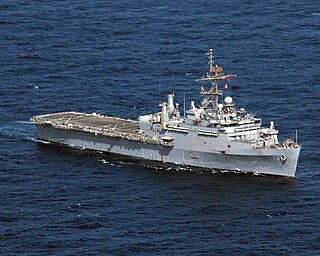
USS Nashville (LPD-13), an Austin-class amphibious transport dock, was the third ship of the United States Navy to be named for the capital city of Tennessee. Her keel was laid down on 14 March 1966 by the Lockheed Shipbuilding and Construction Company of Seattle, Washington. She was launched on 7 October 1967 sponsored by Mrs. Roy L. Johnson, and commissioned at Puget Sound Naval Shipyard, Bremerton, Washington, on 14 February 1970 with Captain Frank R. Fahland in command.

The United States Second Fleet is a numbered fleet in the United States Navy responsible for the East Coast and North Atlantic Ocean. The Fleet was established following World War II. In September 2011, Second Fleet was deactivated in view of the United States Government's perception that the potential military threat posed by Russia had diminished. On 4 May 2018, Admiral John M. Richardson, the Chief of Naval Operations, announced plans to reestablish Second Fleet amid heightened tensions between NATO and Russia. It was reestablished on 24 August 2018, with Vice Admiral Andrew "Woody" Lewis in command.

USS Iwo Jima (LHD-7) is a Wasp-class amphibious assault ship of the United States Navy. The ship was named for the Battle of Iwo Jima of World War II. The ship was commissioned in 2001 and is currently in service.

United States Space Command (USSPACECOM) is a unified combatant command of the United States Department of Defense.

The United States Southern Command (USSOUTHCOM), located in Doral, Florida in Greater Miami, is one of the eleven unified combatant commands in the United States Department of Defense. It is responsible for providing contingency planning, operations, and security cooperation for Central and South America, the Caribbean, their territorial waters, and for the force protection of U.S. military resources at these locations. USSOUTHCOM is also responsible for ensuring the defense of the Panama Canal and the canal area. As explained below, USSOUTHCOM has been under scrutiny due to several human rights and rule of law controversies in which it has been embroiled for nearly a decade.
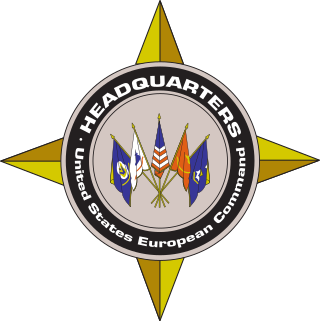
The United States European Command (EUCOM) is one of the eleven unified combatant commands of the United States military, headquartered in Stuttgart, Germany. Its area of focus covers 21,000,000 square miles (54,000,000 km2) and 51 countries and territories, including Europe, Russia, Greenland, and Israel. The Commander of the United States EUCOM simultaneously serves as the Supreme Allied Commander, Europe (SACEUR) within NATO—an intergovernmental military alliance. During the Gulf War and Operation Northern Watch, EUCOM controlled the forces flying from Incirlik Air Base.
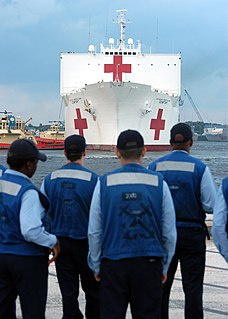
Joint Task Force Katrina was a joint operation between the United States Department of Defense and the Federal Emergency Management Agency created on September 1, 2005 at Camp Shelby, Mississippi to organize relief efforts along the Gulf Coast in the aftermath of Hurricane Katrina. The operation was headed by U.S. Army Lieutenant General Russel L. Honoré. Joint Task Force Katrina took over operations from United States Northern Command that had some elements in place before Hurricane Katrina struck the Gulf Coast.
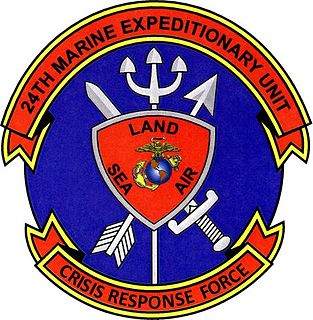
The 24th Marine Expeditionary Unit is one of seven Marine Expeditionary Units currently in existence in the United States Marine Corps. The Marine Expeditionary Unit is a Marine Air Ground Task Force (MAGTF) with a strength of about 2,200 personnel. The MEU consists of a Command Element, a Ground Combat Element based on a reinforced infantry battalion, an Aviation Combat Element based on a reinforced tiltrotor squadron, and a Logistics Command Element based on a Combat Logistics Battalion. The 24th MEU is currently based out of Marine Corps Base Camp Lejeune, North Carolina.
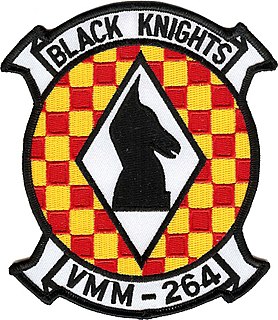
Marine Medium Tiltrotor Squadron 264 (VMM-264) is a United States Marine Corps tiltrotor squadron consisting of MV-22 Osprey transport aircraft. The squadron, known as the "Black Knights", is based at Marine Corps Air Station New River, North Carolina, and normally falls under the command of Marine Aircraft Group 26 (MAG-26) and the 2nd Marine Aircraft Wing. They were the last east coast CH-46 Sea Knight squadron to transition to the Osprey.

Combined Joint Task Force – Horn of Africa (CJTF-HOA) is a joint task force of United States Africa Command (AFRICOM). It originated under Operation Enduring Freedom – Horn of Africa (OEF-HOA) as part of the United States response to the September 11, 2001 attacks.
Humanitarian aid during the 2006 Lebanon War refers to international efforts for civilian assistance during the 2006 Lebanon War.
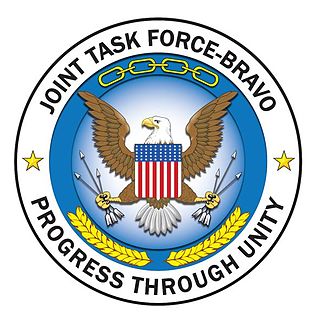
Joint Task Force-Bravo is a forward-based expeditionary joint task force operating as U.S. Southern Command's (USSOUTHCOM) lead forward element in the Central America (CENTAM) region to promote stability and security and counter transnational and transregional threat networks (C-T3N). JTF-Bravo operates out of Soto Cano Air Base, Honduras, located 10 miles south of the city of Comayagua and 50 miles north of the capital city of Tegucigalpa.
The structure of the United States Navy consists of four main bodies: the Office of the Secretary of the Navy, the Office of the Chief of Naval Operations, the operating forces, and the Shore Establishment.
Joint Task Force Aztec Silence is a United States Department of Defense task force conducting anti-terrorism operations. In testimony before the Senate Armed Services Committee on 1 March 2005, then-United States European Command commander General James L. Jones said:

Joint Task Force Liberia was a joint task force formed from August to October 2003 in response to the crisis that developed during the Second Liberian Civil War. The ongoing civil war destabilized the area and created a large number of refugees as rebel forces closed in on Monrovia and took over Bushrod Island. As a result, the Freeport of Monrovia closed, causing food shortages.
Expeditionary Strike Group SEVEN/Task Force 76 is a United States Navy task force. It is at one and the same time operationally a Task Force of the United States Seventh Fleet and administratively, the USN's only permanently forward-deployed Expeditionary Strike Group. It is based at the White Beach Naval Facility at the end of the Katsuren Peninsula in Uruma City, Okinawa, Japan.

Black Sea Area Support Team (BS-AST) is a United States European Command initiative executed by U.S. Army Europe (USAREUR) designed to strengthen relationships between the United States and its Eastern European allies. This program is an innovative element of the Theater Security Cooperation program that focuses on enhancing partner capacity and fostering regional cooperation. TF-East provides the U.S. and its partners in Romania and Bulgaria with training facilities and, currently, a periodic integrated combined staff that stands up to facilitate combined training.
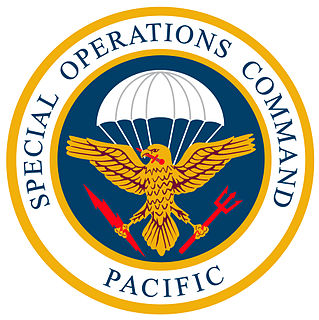
The Special Operations Command Pacific, known as SOCPAC, is a sub-unified command of the United States Department of Defense for special operations forces in the U.S. Pacific Command area of responsibility.

Source: JTF-HD PAO

The 224th Joint Communications Support Squadron, located in Brunswick, Georgia, provides deployable tactical communications for Joint Task Force (JTF) Headquarters and Joint Special Operations Task Force (JSOTF) Headquarters. It can operate in environments without a reliable terrestrial network. The squadron operationally reports to the Joint Communications Support Element at MacDill Air Force Base, Florida.
All information in this article comes from the public domain via attached U.S. government external links and various U.S. military press releases.

















